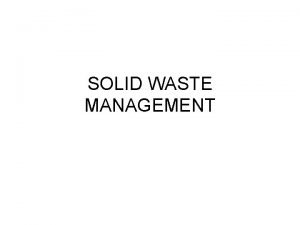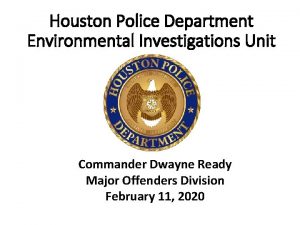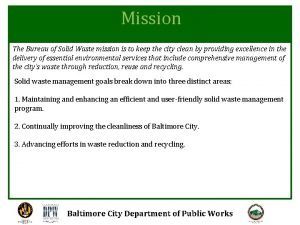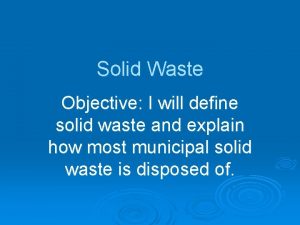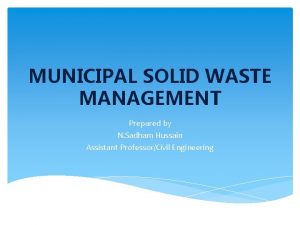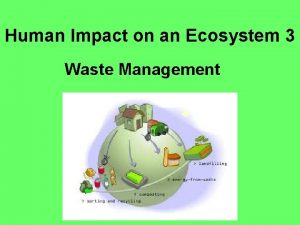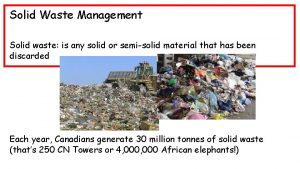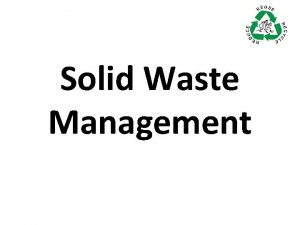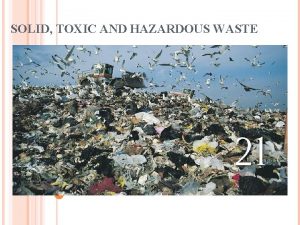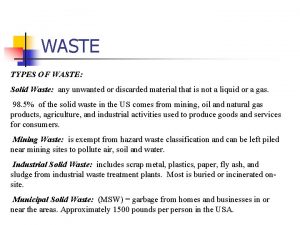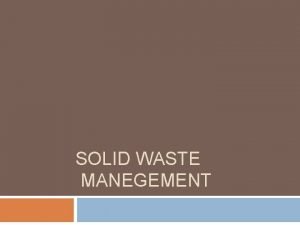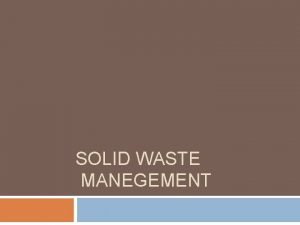Solid Waste What is a solid waste Any













- Slides: 13

Solid Waste

What is a solid waste? • Any material that we discard, that is not liquid or gas, is solid waste • Municipal Solid Waste (MSW): • Solid waste from home or office • Industrial Solid Waste: • Solid waste produced from Mines, Agriculture or Industry

What is a Hazardous Waste? Hazardous waste is a waste with properties that make it dangerous or potentially harmful to human health or the environment Ignitability - Ignitable wastes create fires under certain conditions or are spontaneously combustible, or have a flash point less than 60 °C (140 °F). Corrosivity - Corrosive wastes are acids or bases (p. H less than or equal to 2 or greater than or equal to 12. 5) that are capable of corroding metal containers, such as storage tanks, drums, and barrels. Reactivity - Reactive wastes are unstable under "normal" conditions. They can cause explosions, toxic fumes, gases, or vapors when mixed with water. Toxicity - Toxic wastes are harmful or fatal when ingested or absorbed (e. g. , containing mercury, lead, etc. ). When toxic wastes are disposed of on land, contaminated liquid may drain (leach) from the waste and pollute ground water. Toxicity is defined through a laboratory procedure called the Toxicity Characteristic Leaching Procedure (TCLP). Major types: Organics and Heavy Metals, Radioactive wastes

What are Methods of Dealing with Municipal Waste? • On-site (at home) • Open Dump • Sanitary Landfill • Incineration • Ocean dumping

Open Dump • Unsanitary, draws pests and vermin, harmful runoff and leachates, toxic gases • Still accounts for half of solid waste • Several thousand open dumps in the USA

Sanitary Landfill Layer of compacted trash covered with a layer of earth once a day and a thicker layer when the site is full Require impermeable barriers to stop escape of leachates: can cause problem by overflow Gases produced by decomposing garbage needs venting 1 acre/10, 000 people: acute space problem: wastes piling up over 150 million tons/year; Number of landfills down from 8000(1988) to 3091(1996) Methane Production

Sanitary Landfill • Avoid: • Swampy area/ Flood plains /coastal areas • Fractures or porous rocks • High water table • Prefer: • Clay layers • Heads of gullies

Monitoring of Sanitary Landfills Gases: Methane, Ammonia, Hydrogen sulphide Heavy Metals: Lead, Chromium in soil Soluble substances: chloride, nitrate, sulfate Surface Run-offs Vegetation: may pick up toxic substances Plant residue in soil Paper/plastics etc – blown by the wind

Incineration Solves space problem but: produces toxic gases like Cl, HCN, SO 2 High temp furnaces break down hazardous compounds but are expensive ($75 - $2 K/ton) Heat generated can be recovered: % of waste burnt Japan 67%, Switzerland 80%, USA 6% North Little Rock, AK saving $50 K in heating cost and reducing landfill requirement by 95% How many MSW combustors exist in the United States? In 1996, 110 combustors with energy recovery existed with the capacity to burn up to 100, 000 tons of MSW per day.

Ocean Dumping Out of sight, free of emission control norms Contributes to ocean pollution Can wash back on beaches, and can cause death of marine mammals Preferred method: incineration in open sea Ocean Dumping Ban Act, 1988: bans dumping of sewage sludge and industrial waste Dredge spoils still dumped in oceans, can cause habitat destruction and export of fluvial pollutants

Reducing Waste • Incineration, compacting • Hog feed: requires heat treatment • Composting: requires separation of organics from glass and metals • Recycling and Reusing

What are the Benefits of Recycling? • USA recycled 83 million tons of MSW. • This provides an annual benefit of 182 million metric tons of carbon dioxide equivalent emissions reduced, • comparable to removing the emissions from 33 million passenger cars. • But the ultimate benefits from recycling are cleaner land, air, and water, overall better health, and a more sustainable economy.

What is Liquid Waste? Sewage Highly toxic Industrial Waste & Used Oil Dilute and Disperse Concentrate and Contain Secure Landfill Sealed drums to be put in impermeable holds with monitoring wells to check for leakage: does not work Deep well Disposal Pumping in deep porous layer bounded by impermeable formations, well below water table $1 million to drill, $15 -20/ton afterwards Restricted by geological considerations, can trigger earthquakes
 Informational probes adalah
Informational probes adalah Some any cheese
Some any cheese Any to any connectivity
Any to any connectivity Waste is any material that is not needed by the owner
Waste is any material that is not needed by the owner Solid waste management
Solid waste management Conclusion of waste management
Conclusion of waste management Solid
Solid Nakasaad sa batas ra 9147
Nakasaad sa batas ra 9147 Solid
Solid Define solid waste
Define solid waste Trash haulers grenada
Trash haulers grenada What is allied health professionals
What is allied health professionals Solid and hazardous waste
Solid and hazardous waste Waste management 3r
Waste management 3r



